 French outfit Archos has launched what they claim is the first portable digital TV receiver/ recorder combining portable video recorder (PVR) functionality and two DTT (Digtial Terrestrail Television) tuners.
French outfit Archos has launched what they claim is the first portable digital TV receiver/ recorder combining portable video recorder (PVR) functionality and two DTT (Digtial Terrestrail Television) tuners.
Sporting two antennas working in parallel and two DTT tuners, the AV 700 TV uses a ‘mobile diversity processing reception system’ which improves reception inside buildings and on the move.
The makers claim that that digital TV can be viewed in cars hurtling along at speeds up to 130 km/h [80mph] – something that isn’t possible with standard single-antenna DTT receivers.
 The built-in DVR records digital TV directly to the hard disk in MPEG2 TS format, and there’s an onboard Electronic Programme Guide (EPG) for scheduled recordings (so long as you can get reception, natch).
The built-in DVR records digital TV directly to the hard disk in MPEG2 TS format, and there’s an onboard Electronic Programme Guide (EPG) for scheduled recordings (so long as you can get reception, natch).
With its 7″ (480×234 pixels, 262k colour) wide screen display, it’s a chunky gizmo which would have trouble fitting into even Fatty Arbuckle’s capacious pockets.
With its 40GB storage capacity, the AV 700 TV can squeeze in up to 35 hours of recorded digital TV programs, 130 hours of encoded videos, 400,000 photos or 20,000 songs, which should be enough to keep even the most hyperactive teenager entertained between Coke cans.
 An optional 100GB version offers even more storage, which equates to, err, lots more videos, songs and stuff.
An optional 100GB version offers even more storage, which equates to, err, lots more videos, songs and stuff.
Handily, users can preset up to five different locations (e.g. home, work, pub) to avoid wearing out the retune control as they amble between transmitters.
Henri Crohas, ARCHOS CEO was well chuffed, declaring his company to be, “elated to be part of the exciting new wave of digital TV technology” and “proud to introduce a portable device for viewing and recording free digital TV in all sorts of places outside the living room.”
He then rather blotted his copy book be referring to the beautiful game as ‘soccer’, while declaring the AV 700 TV to be the “perfect gadget to watch and record the World Cup soccer championship this summer wherever you are.”
“Imagine recording a match while at work and then watching it during the nightly commute back home,” he added.
 We reckon that someone whipping out a large, expensive multimedia device on a London train would soon have no trouble imagining filling in an insurance claim, but with no UK launch announced, perhaps the muggers will have to wait for now.
We reckon that someone whipping out a large, expensive multimedia device on a London train would soon have no trouble imagining filling in an insurance claim, but with no UK launch announced, perhaps the muggers will have to wait for now.
However, the AV700 is expected to available in Europe around May with pricing hovering around the €700 (£485) mark.
Specifications
Capacity: 40 GB Hard drive 100 GB Hard drive
Display: 7″ LCD 480×234 pixels, 262 000 colours and TV output.
Video recording: MPEG-47 SP and stereo sound, optimised resolution for TV up to 640×480 @ 30 f/s, in AVI format
Video playback: MPEG-47 SP with B-Frames with stereo sound. Near DVD quality up to 720×480 @ 30 f/s (NTSC), 720×576 @ 25 f/s (PAL), AVI file format. WMV9 (including protected files) up to 352×288 @ 30 f/s, and 800 KBit/s4.
Music recording: From an analog source in stereo sound for WAV (PCM & ADPCM) format.
Music playback: Stereo MP3 decoding @ 30-320 kb/s CBR & VBR, WMA (including protected WMA files), WAV (PCM & ADPCM).
Photo viewer: JPEG (except progressives) or BMP.
AV connections: Earphones / Audio & Video line out. TV pod with video pass through, AV in & out cables (SCART In & Out for European version) and IR emitter cable for tuner control of VCR, cable box or satellite receiver.
Speaker: Built-in speakers.
Interfaces: USB 2.0 high-speed device, compatible USB 1.1, PC & Mac.
USB Host port compatible Mass Storage Device.
Battery life: Up to 30 hours, 6 for music. Up to 4 hours6 for video on built-in LCD. Removable battery (additional battery optional)
Dimensions: Approx. 10.7 x 20.9 x 1.9 cm – 4.2″ x 8.2″ x 0.8″
Weight: Approx. 590 g – 20.8 oz
Package includes: AV 700, USB 2.0 cable, USB host adapter, AC adapter & charger, stereo headphones, protective case, user guide, TV Pod, remote control (with batteries), audio/video cables (SCART in and SCART out for European version). Archaos
 In a few years time, kids will be clutching their sides and laughing at the thought that their parents used to watch TV on massive great boxes that filled up half the living room.
In a few years time, kids will be clutching their sides and laughing at the thought that their parents used to watch TV on massive great boxes that filled up half the living room. Style over picture
Style over picture “Would you like a single piece of sheet music that contains all your favourite pieces, and never needs to be turned over?”
“Would you like a single piece of sheet music that contains all your favourite pieces, and never needs to be turned over?” The universal piece of music wasn’t even the first prize winner in this competition. It was a contest sponsored by one of the world’s leading e-paper technology designers, Plastic Logic, which has demonstrated a flexible sheet of A5 “paper” that has the contrast and readability of real paper, the flexibility of soft cardboard, and the power consumption of a watch. And the prize went to something that is, in the end, “just a book.”
The universal piece of music wasn’t even the first prize winner in this competition. It was a contest sponsored by one of the world’s leading e-paper technology designers, Plastic Logic, which has demonstrated a flexible sheet of A5 “paper” that has the contrast and readability of real paper, the flexibility of soft cardboard, and the power consumption of a watch. And the prize went to something that is, in the end, “just a book.”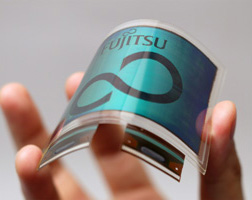 When you invent a new technology, you always start off by producing something which you know has a market already, and which you think you can do better.
When you invent a new technology, you always start off by producing something which you know has a market already, and which you think you can do better.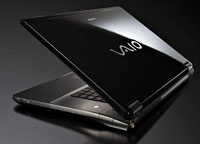 Sony has whipped out its first laptop equipped with a next-generation Blu-ray optical disk drive, saying that it will be available in Japan next month.
Sony has whipped out its first laptop equipped with a next-generation Blu-ray optical disk drive, saying that it will be available in Japan next month.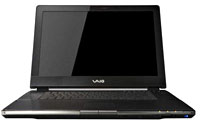 The AR-Series will also come with a HDMI (High Definition Multimedia Interface) output for hooking up the lappie to a HD-ready TV or Full HD desktop display.
The AR-Series will also come with a HDMI (High Definition Multimedia Interface) output for hooking up the lappie to a HD-ready TV or Full HD desktop display.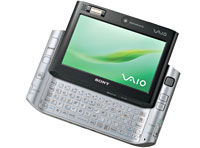 Powered by Intel Core Solo U1400 (1.2 Ghz)/U1300 (1.06 Ghz) the pint-sized PC will sport an Intel 945GMS Express chipset, 512MB RAM, 20/30 GB hard drive and 69 key QWERTY keyboard.
Powered by Intel Core Solo U1400 (1.2 Ghz)/U1300 (1.06 Ghz) the pint-sized PC will sport an Intel 945GMS Express chipset, 512MB RAM, 20/30 GB hard drive and 69 key QWERTY keyboard.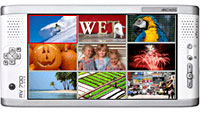 French outfit Archos has launched what they claim is the first portable digital TV receiver/ recorder combining portable video recorder (PVR) functionality and two DTT (Digtial Terrestrail Television) tuners.
French outfit Archos has launched what they claim is the first portable digital TV receiver/ recorder combining portable video recorder (PVR) functionality and two DTT (Digtial Terrestrail Television) tuners.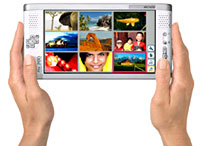 The built-in DVR records digital TV directly to the hard disk in MPEG2 TS format, and there’s an onboard Electronic Programme Guide (EPG) for scheduled recordings (so long as you can get reception, natch).
The built-in DVR records digital TV directly to the hard disk in MPEG2 TS format, and there’s an onboard Electronic Programme Guide (EPG) for scheduled recordings (so long as you can get reception, natch). An optional 100GB version offers even more storage, which equates to, err, lots more videos, songs and stuff.
An optional 100GB version offers even more storage, which equates to, err, lots more videos, songs and stuff. We reckon that someone whipping out a large, expensive multimedia device on a London train would soon have no trouble imagining filling in an insurance claim, but with no UK launch announced, perhaps the muggers will have to wait for now.
We reckon that someone whipping out a large, expensive multimedia device on a London train would soon have no trouble imagining filling in an insurance claim, but with no UK launch announced, perhaps the muggers will have to wait for now.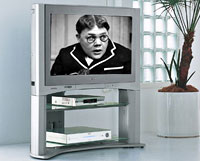 It looks like the days of chunky, clunky cathode ray tube TVs are numbered as worldwide revenues from slimline LCD (liquid crystal displays) TVs surpassed those of cathode-ray (CRT) televisions in the fourth quarter last year.
It looks like the days of chunky, clunky cathode ray tube TVs are numbered as worldwide revenues from slimline LCD (liquid crystal displays) TVs surpassed those of cathode-ray (CRT) televisions in the fourth quarter last year.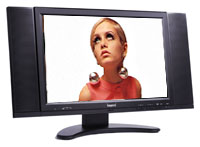 Sales were healthy for plasma-screen televisions, growing 31.3 percent to reach $5.29 billion in the same quarter, giving them the third-largest share of the market after LCD TVs and cathode-ray TVs.
Sales were healthy for plasma-screen televisions, growing 31.3 percent to reach $5.29 billion in the same quarter, giving them the third-largest share of the market after LCD TVs and cathode-ray TVs.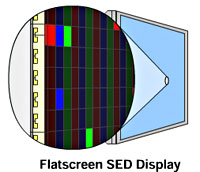 Look out LCDs – here comes SED displays
Look out LCDs – here comes SED displays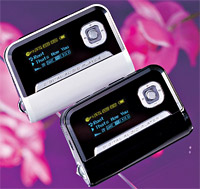 MobiBlu’s soon-to-be-released DAH-1900 MP3 Player (256mb/512mb/1gb) claims to have the longest battery life of any MP3 player in the entire known universe.
MobiBlu’s soon-to-be-released DAH-1900 MP3 Player (256mb/512mb/1gb) claims to have the longest battery life of any MP3 player in the entire known universe.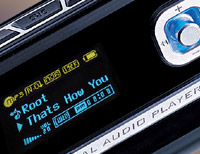 The display can be used to stream song lyrics for pub-like solo singalongs, courtesy of an editable Auto Lyric system.
The display can be used to stream song lyrics for pub-like solo singalongs, courtesy of an editable Auto Lyric system. For nippy transfer of files from a PC, the DAH-1900 offers a High-Speed USB 2.0 interface at up to 40 Mbps transmission speed.
For nippy transfer of files from a PC, the DAH-1900 offers a High-Speed USB 2.0 interface at up to 40 Mbps transmission speed.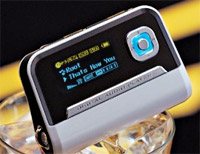 Available colours
Available colours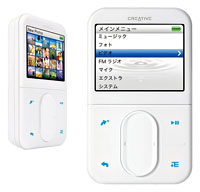 Creative Zen Vision:M
Creative Zen Vision:M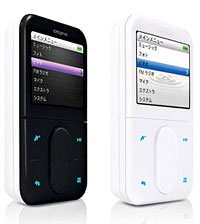 The player’s a versatile chap too, with the Vision:M outgunning the iPod by supporting a wider range of formats, like MP3, WMA and PlaysForSure audio formats and MPEG1/2/4, DivX and XviD, Motion JPEG and WMV for video.
The player’s a versatile chap too, with the Vision:M outgunning the iPod by supporting a wider range of formats, like MP3, WMA and PlaysForSure audio formats and MPEG1/2/4, DivX and XviD, Motion JPEG and WMV for video.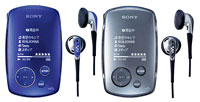 Sony NW-A1000
Sony NW-A1000 The palm sized player (88 x 55 x 19 mm) comes with a built in 6GB hard drive and supports MP3 files as well as Sony’s ATRAC3 and ATRAC3+ audio formats. Battery life is claimed at 20 hours (although several reviews have found that figure to be wildly optimistic).
The palm sized player (88 x 55 x 19 mm) comes with a built in 6GB hard drive and supports MP3 files as well as Sony’s ATRAC3 and ATRAC3+ audio formats. Battery life is claimed at 20 hours (although several reviews have found that figure to be wildly optimistic).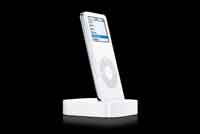 Apple iPod Nano
Apple iPod Nano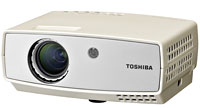 It wasn’t that long ago that lugging around a projector was the first step on the painful route to a guaranteed hernia, but thanks to the wizardry of boffins and the onward march of technology, projectors are no longer the size of small houses.
It wasn’t that long ago that lugging around a projector was the first step on the painful route to a guaranteed hernia, but thanks to the wizardry of boffins and the onward march of technology, projectors are no longer the size of small houses.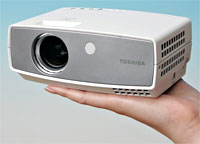 The TDP-FF1A (try saying that with a mouthful of tea) also comes with a handy USB port to let photographers directly display their photos straight off the camera.
The TDP-FF1A (try saying that with a mouthful of tea) also comes with a handy USB port to let photographers directly display their photos straight off the camera.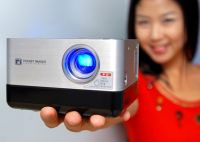 Also shown off at the September IFA 2005 in Berlin was Samsung’s neat Pocket Imager SP-P300M projector.
Also shown off at the September IFA 2005 in Berlin was Samsung’s neat Pocket Imager SP-P300M projector.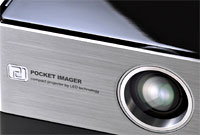 The attractive LED projector sports a contrast ratio is 1000:1 with an impressively high claimed bulb life of 10,000 hours.
The attractive LED projector sports a contrast ratio is 1000:1 with an impressively high claimed bulb life of 10,000 hours.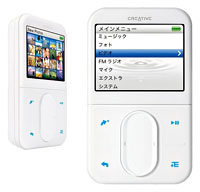 Creative are set to take on Apple’s video-enabled fifth-generation iPod with their new Zen Vision:M player, due to be announced tomorrow.
Creative are set to take on Apple’s video-enabled fifth-generation iPod with their new Zen Vision:M player, due to be announced tomorrow.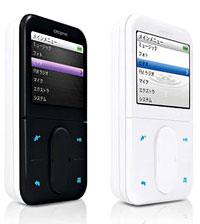 Creative claim that the rechargeable battery can keep punters entertained for four hours in video-playback mode – twice as long as the iPod’s two hours.
Creative claim that the rechargeable battery can keep punters entertained for four hours in video-playback mode – twice as long as the iPod’s two hours.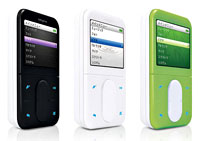 It’s a shame seeing a company as, err, creative as Creative coming up with a design so obviously ‘inspired’ by the iPod, but perhaps it’s a sign that they’re signing up to a philosophy of, “if you can’t beat them, join them.”
It’s a shame seeing a company as, err, creative as Creative coming up with a design so obviously ‘inspired’ by the iPod, but perhaps it’s a sign that they’re signing up to a philosophy of, “if you can’t beat them, join them.” Following on from his review of the
Following on from his review of the 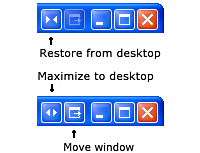 With support for more than ten monitors, UltraMon adds a raft of user-configurable tools to help users get a manly grip on their acres of screen real estate.
With support for more than ten monitors, UltraMon adds a raft of user-configurable tools to help users get a manly grip on their acres of screen real estate.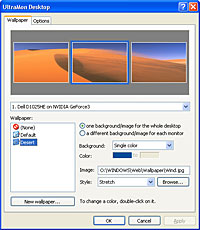 These little fellas let you quickly shunt programs across to other screens with a single click, or maximise a single window across the entire desktop.
These little fellas let you quickly shunt programs across to other screens with a single click, or maximise a single window across the entire desktop.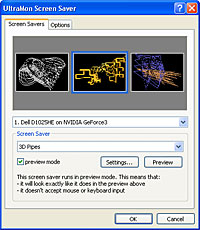 The program also lets you stretch desktop wallpapers and screen savers across multiple screens or set a different picture and screen saver for each screen, which can look way cool!
The program also lets you stretch desktop wallpapers and screen savers across multiple screens or set a different picture and screen saver for each screen, which can look way cool!